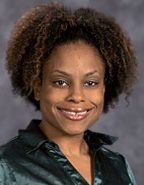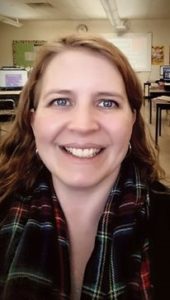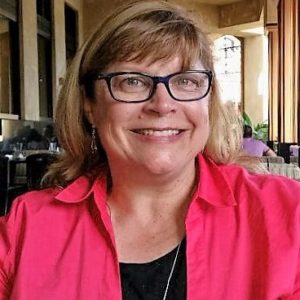Wednesday, April 24 is the last day to submit an application for the Code.org Professional Learning Program in Ohio for the priority application window. Details about the program are posted here and you can apply on Code.org’s website. Through April, we brought you two quick conversations with Ohio teachers implementing computer science with the support of these trainings.
For those of you who couldn’t join us in person, we’re pleased to offer transcripts of those conversations below, along with a few highlighted responses from these teachers.
Teacher Chat: Bringing Computer Science to Middle School with Elizabeth Davis (Wadsworth Schools) and La Shawna Grimes (Emmanuel Christian Academy)
What was the Code.org Professional Learning program like for you?
 La Shawna: For me, my masters is in instructional technology so when I got promoted to technology director, I was also told I was teaching technology. Mostly they wanted me to teach typing. With other stuff trickled in there. But in my masters I kind of really had a pulling towards coding. So I was looking for a program that I could incorporate into the classroom even be for my students. And I came across Code.org, just researching it online and I did it the first year, Computer Science Discoveries, all on my own, before I got into the program. That made me think, okay I need to get into the program. It was hard. I didn’t have a lot of know-how about how to do it. I did have the resources so, that was great because you guys have a ton of videos. But the timing and assessment was really hard for me.
La Shawna: For me, my masters is in instructional technology so when I got promoted to technology director, I was also told I was teaching technology. Mostly they wanted me to teach typing. With other stuff trickled in there. But in my masters I kind of really had a pulling towards coding. So I was looking for a program that I could incorporate into the classroom even be for my students. And I came across Code.org, just researching it online and I did it the first year, Computer Science Discoveries, all on my own, before I got into the program. That made me think, okay I need to get into the program. It was hard. I didn’t have a lot of know-how about how to do it. I did have the resources so, that was great because you guys have a ton of videos. But the timing and assessment was really hard for me.
I’m going through the program, that helps. I was able to learn how to better time out the lessons. I was able to learn how to introduce the lessons and maybe different ways to introduce the lessons that I had been doing. And also I was able to learn about a ton of resources through the teacher community.
 Elizabeth: When I heard that Code.org was coming up with a middle school program, I applied to pilot and was accepted. Which I was really excited about because there were 42 people across the U.S. and I was able to do that. It was definitely a crash course. The work that we do in one week and the four workshops throughout the school year (in the current training model), we did (originally) in three days in Arizona. They took us all out there and we did that over three days and then we used that curriculum and met with the Code.org staff regularly throughout the school year.
Elizabeth: When I heard that Code.org was coming up with a middle school program, I applied to pilot and was accepted. Which I was really excited about because there were 42 people across the U.S. and I was able to do that. It was definitely a crash course. The work that we do in one week and the four workshops throughout the school year (in the current training model), we did (originally) in three days in Arizona. They took us all out there and we did that over three days and then we used that curriculum and met with the Code.org staff regularly throughout the school year.
The thing that kept me coming back, the thing that made me want to be a facilitator and work with Code.org was that they are so responsive to teachers. They wanted to incorporate what actually happens when the rubber hits the road in the classroom.
What advice do you have for a teacher or a principal considering offering computer science discovery to their students next year?
La Shawna: Be open. Be flexible. Be willing to learn, that’s it. Just like we tell the students, it’s okay to not know everything and to make mistakes just as long as we learn how to improve upon it. And it’s going to be a work in progress and you’ll get better and better each time.
Elizabeth: I guess I would be speaking more directly to those people who are on the fence. Whether or not to bring computer science to their classes or to their schools. I feel like our job is always to prepare students for what’s coming and we don’t really know that. But we do know that computer science is going to be a part of it. So it feels like it just needs to be a part of the curriculum and if you don’t have it there already, this is such a nice entry point. And to just be curious. Along with what La Shawna said, all of those things and I would add, be curious. Because, your kids are.
Download the rest of the transcript
Teacher Chat: Bringing Computer Science to High School with Anne Trachsel (Reynoldsburg eSTEM Academy)
Can you talk a little bit about what Computer Science Principles in particular entails?
 Anne Trachsel: Computer Science Principles is one of my favorite classes to teach. It’s a survey of a lot of computer science topics. We talk about how the internet works, we talk about how data is stored inside the computer, how an image is stored. Black and white, and color, and about compression with respect to prongs and grooving. There are two programming units and then there is a unit that talks about big data and security. We do a little cyber security, some kind of things about how you can be secure, how you can use different ciphers and things to keep that security up. The curriculum is wonderful, it’s interactive. We do a lot of things with some very cool online tools. One of the others things that I really like about it is, based on what the students’ interest is, they have a lot of choice in their project of what they can put together.
Anne Trachsel: Computer Science Principles is one of my favorite classes to teach. It’s a survey of a lot of computer science topics. We talk about how the internet works, we talk about how data is stored inside the computer, how an image is stored. Black and white, and color, and about compression with respect to prongs and grooving. There are two programming units and then there is a unit that talks about big data and security. We do a little cyber security, some kind of things about how you can be secure, how you can use different ciphers and things to keep that security up. The curriculum is wonderful, it’s interactive. We do a lot of things with some very cool online tools. One of the others things that I really like about it is, based on what the students’ interest is, they have a lot of choice in their project of what they can put together.
What has been the most challenging part of implementing Computer Science Principles?
Anne Trachsel: I think with a lot of classes, the challenge is, you have a lot of different kinds of students who walk through your door and you want to give them all a really great experience. I have students who have never had a computer science class before and I have students who have had a few computer science classes before. You want to try to meet them all where they are and help them move forward.
This curriculum really helps with that because it’s so interactive. The lesson plans include extensions, so if there are students who come in with some different experiences already, it gives you some ideas of places you can go and ways that you can help them to learn new things, while you’re still helping the students for whom it’s still brand new, so that nobody feels lost and left out.
Computer Science Principles can be offered as an AP course, and we encourage teachers to offer it. It can also be an introduction course. Teachers do have a choice, especially if you’re at a school who doesn’t typically offer AP courses. What is the AP experience like for you and your students?
Anne Trachsel: I actually teach students who are taking this for AP and students who are not taking this for AP within the same classroom, so we have both. It works pretty well, it works very well for both kinds of students. Typically, we will cover the same material. Students who are taking it for AP, they need a different sort of rubrics, for example, than the students who aren’t.